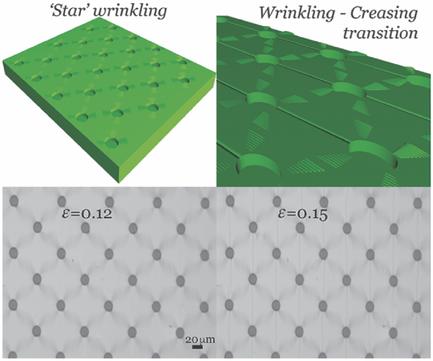当前位置:
X-MOL 学术
›
Adv. Funct. Mater.
›
论文详情
Our official English website, www.x-mol.net, welcomes your feedback! (Note: you will need to create a separate account there.)
Spatially Configuring Wrinkle Pattern and Multiscale Surface Evolution with Structural Confinement
Advanced Functional Materials ( IF 19.0 ) Pub Date : 2017-11-07 , DOI: 10.1002/adfm.201704228 Ding Wang 1 , Nontawit Cheewaruangroj 2 , Yifan Li 1 , Glen McHale 1 , Yinzhu Jiang 3 , David Wood 4 , John Simeon Biggins 5 , Ben Bin Xu 1
Advanced Functional Materials ( IF 19.0 ) Pub Date : 2017-11-07 , DOI: 10.1002/adfm.201704228 Ding Wang 1 , Nontawit Cheewaruangroj 2 , Yifan Li 1 , Glen McHale 1 , Yinzhu Jiang 3 , David Wood 4 , John Simeon Biggins 5 , Ben Bin Xu 1
Affiliation

|
Surface elastic instabilities, such as wrinkling and creasing, can enable a convenient strategy to impart reversible patterned topography to a surface. Here the classic system of a stiff layer on a soft substrate is focused, which famously produces parallel harmonic wrinkles at modest uniaxial compression that period‐double repeatedly at higher compressions and ultimately evolve into deep folds and creases. By introducing micrometer‐scale planar Bravais lattice holes to spatially pattern the substrate, these instabilities are guided into a wide variety of different patterns, including wrinkling in parallel bands and star shape bands, and radically reduce the threshold compression. The experimental patterns and thresholds are enabled to understand by considering a simple plane‐strain model for the patterned substrate‐deformation, decorated by wrinkling on the stiff surface layer. The experiments also show localized wrinkle‐crease transitions at modest compression, yielding a hierarchical surface with different generations of instability mixed together. By varying the geometrical inputs, control over the stepwise evolution of surface morphologies is demonstrated. These results demonstrate considerable control over both the patterns and threshold of the surface elastic instabilities, and have relevance to many emerging applications of morphing surfaces, including in wearable/flexible electronics, biomedical systems, and optical devices.
中文翻译:

通过结构限制在空间上配置皱纹图案和多尺度表面演化
表面弹性不稳定性(例如起皱和折皱)可以实现一种方便的策略,以将可逆的图案形貌赋予表面。此处重点介绍了在软质基材上的经典刚性层系统,该系统在适度的单轴压缩下会产生平行的谐波皱纹,并在较高的压缩下重复周期成倍增加,最终演变为深折痕和折痕。通过引入微米级的平面Bravais晶格孔在空间上对基板进行构图,这些不稳定性将被引导为多种不同的图案,包括在平行带和星形带中起皱,并从根本上降低了阈值压缩。通过考虑用于图案化基底变形的简单平面应变模型,可以理解实验图案和阈值,通过在坚硬的表面层上起皱来装饰。实验还显示了在适度压缩下的局部皱纹-起皱过渡,产生了具有不同代数不稳定性的分层表面,混合在一起。通过改变几何输入,证明了对表面形态的逐步演变的控制。这些结果表明,可以对表面弹性不稳定性的图案和阈值进行大量控制,并且与变形表面的许多新兴应用(包括在可穿戴/柔性电子产品,生物医学系统和光学设备中)相关。证明了对表面形态逐步演化的控制。这些结果表明,可以对表面弹性不稳定性的图案和阈值进行大量控制,并且与变形表面的许多新兴应用(包括在可穿戴/柔性电子产品,生物医学系统和光学设备中)相关。证明了对表面形态逐步演化的控制。这些结果证明了对表面弹性不稳定性的图案和阈值都有相当大的控制,并且与变形表面的许多新兴应用相关,包括在可穿戴/柔性电子产品,生物医学系统和光学设备中。
更新日期:2017-11-07
中文翻译:

通过结构限制在空间上配置皱纹图案和多尺度表面演化
表面弹性不稳定性(例如起皱和折皱)可以实现一种方便的策略,以将可逆的图案形貌赋予表面。此处重点介绍了在软质基材上的经典刚性层系统,该系统在适度的单轴压缩下会产生平行的谐波皱纹,并在较高的压缩下重复周期成倍增加,最终演变为深折痕和折痕。通过引入微米级的平面Bravais晶格孔在空间上对基板进行构图,这些不稳定性将被引导为多种不同的图案,包括在平行带和星形带中起皱,并从根本上降低了阈值压缩。通过考虑用于图案化基底变形的简单平面应变模型,可以理解实验图案和阈值,通过在坚硬的表面层上起皱来装饰。实验还显示了在适度压缩下的局部皱纹-起皱过渡,产生了具有不同代数不稳定性的分层表面,混合在一起。通过改变几何输入,证明了对表面形态的逐步演变的控制。这些结果表明,可以对表面弹性不稳定性的图案和阈值进行大量控制,并且与变形表面的许多新兴应用(包括在可穿戴/柔性电子产品,生物医学系统和光学设备中)相关。证明了对表面形态逐步演化的控制。这些结果表明,可以对表面弹性不稳定性的图案和阈值进行大量控制,并且与变形表面的许多新兴应用(包括在可穿戴/柔性电子产品,生物医学系统和光学设备中)相关。证明了对表面形态逐步演化的控制。这些结果证明了对表面弹性不稳定性的图案和阈值都有相当大的控制,并且与变形表面的许多新兴应用相关,包括在可穿戴/柔性电子产品,生物医学系统和光学设备中。



























 京公网安备 11010802027423号
京公网安备 11010802027423号